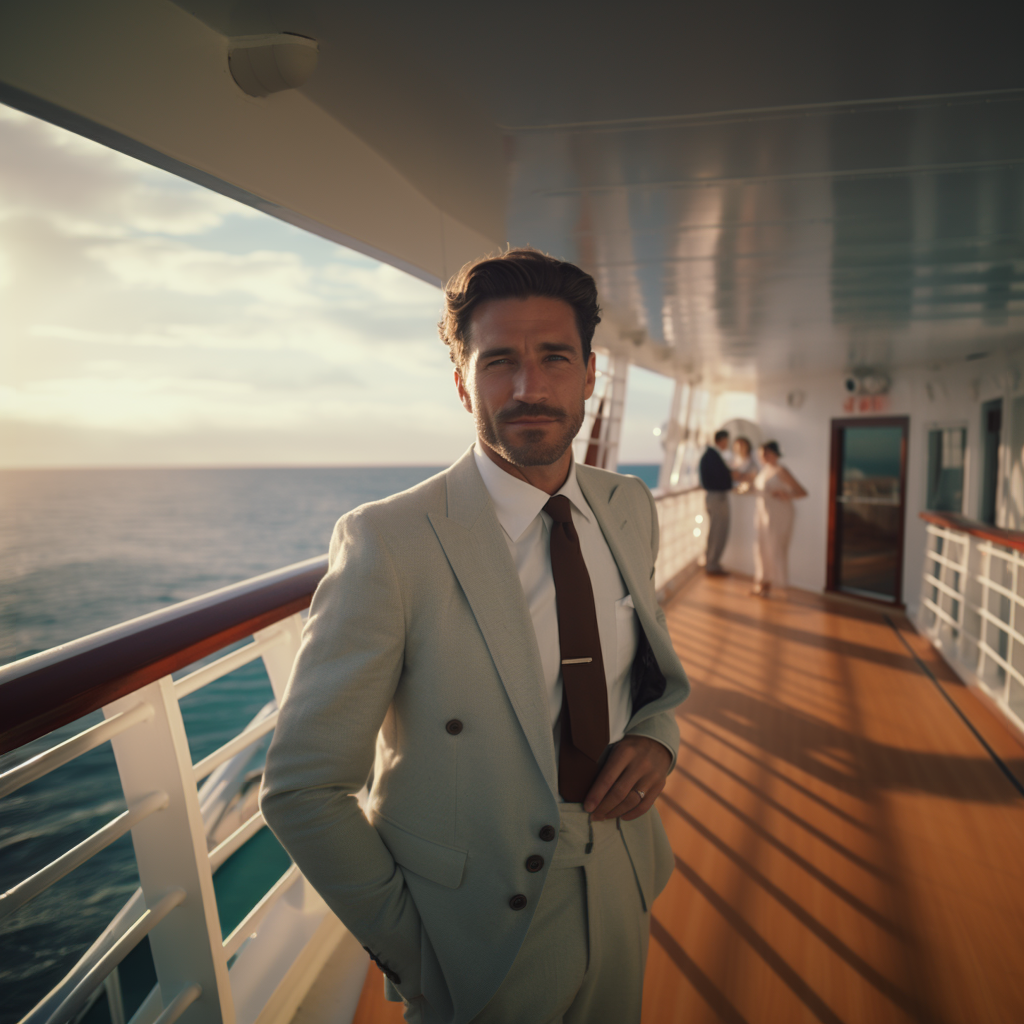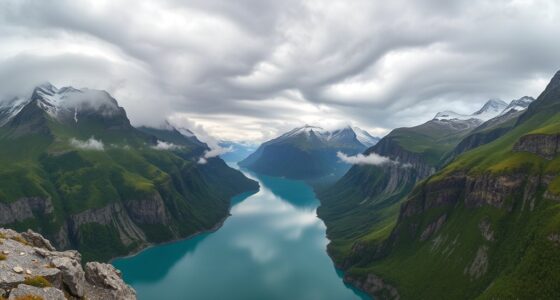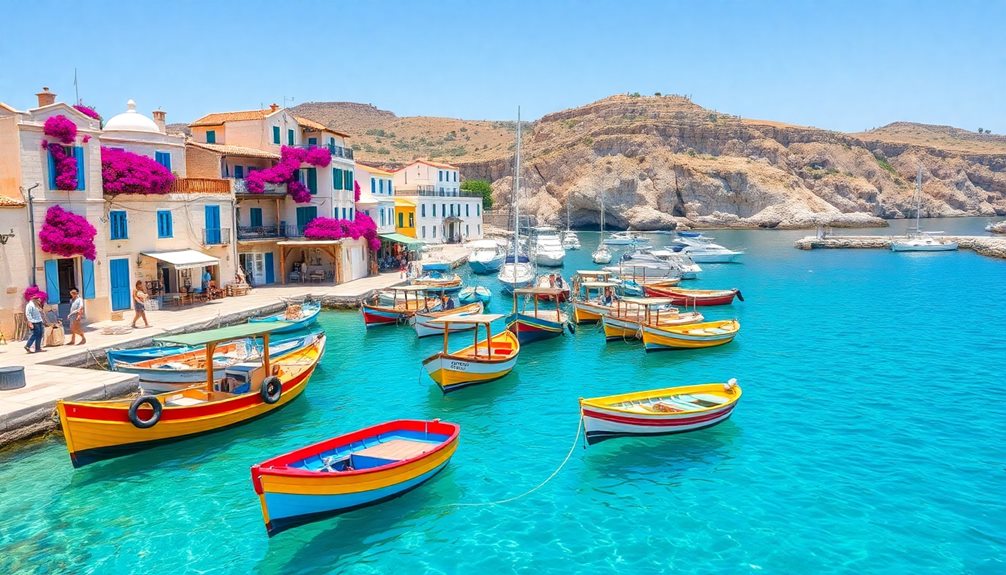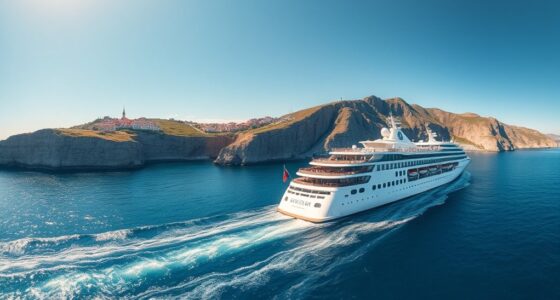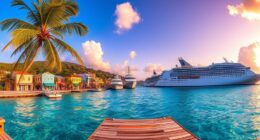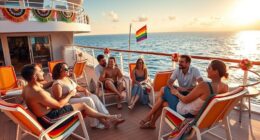The best times to experience Norway's fjords depend on what you're looking for. If you want vibrant landscapes, visit during summer for nearly 24 hours of daylight. For stunning autumn foliage and fewer crowds, September to October is ideal. Winter's the time for whale watching and the Northern Lights, while spring boasts blooming wildflowers and powerful waterfalls. Top spots for viewing include Sognefjord for kayaking, Geirangerfjord for waterfalls, and Lysefjord for hiking Pulpit Rock. Each season offers its charm, and there's much more to uncover about these magnificent locations.
Key Takeaways
- Best Times to Visit: Summer offers mild temperatures and vibrant activities, while winter is ideal for Northern Lights and whale sightings.
- Recommended Viewing Locations: Sognefjord, Geirangerfjord, and Nærøyfjord provide stunning landscapes and outdoor activities throughout the year.
- Wildlife Spotting: Summer is optimal for eagle watching, whale sightings, and seal encounters in various fjords.
- Seasonal Activities: Each season offers unique experiences, from hiking and kayaking in summer to snowmobiling and dog sledding in winter.
- Cultural Events: Attend local festivals like the Riddu Riđđu Festival and the Midnight Sun Marathon for a rich cultural experience.
Best Times to Visit
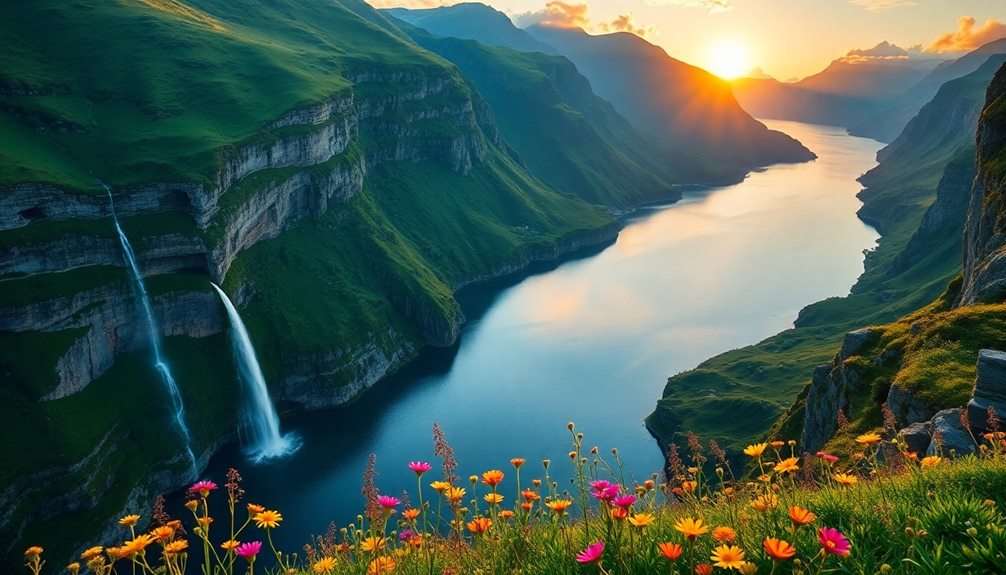
When's the best time to visit the Norwegian fjords? It really depends on what you're looking to experience.
The summer months, from June to August, are the peak tourist season. You'll enjoy mild temperatures and nearly 24 hours of daylight, perfect for outdoor activities like hiking and kayaking.
If you prefer stunning autumn foliage, consider visiting in September or October when the landscape transforms into a vibrant display of colors, and temperatures hover around 6°C (48°F) in Oslo.
If you're drawn to the magical Northern Lights, the winter months from December to February are ideal. While temperatures can plummet to an average of -3°C (25°F), the chance to witness this breathtaking phenomenon makes it worthwhile.
Plus, you might catch a glimpse of whales during this season!
Spring, from March to May, offers blooming wildflowers and longer daylight hours, signaling the fjords' transformation.
Each season brings its unique charm, so think about your interests and what you want to see. Ultimately, the best time to visit the Norwegian fjords is the one that aligns with your personal adventure!
Summer Viewing Opportunities
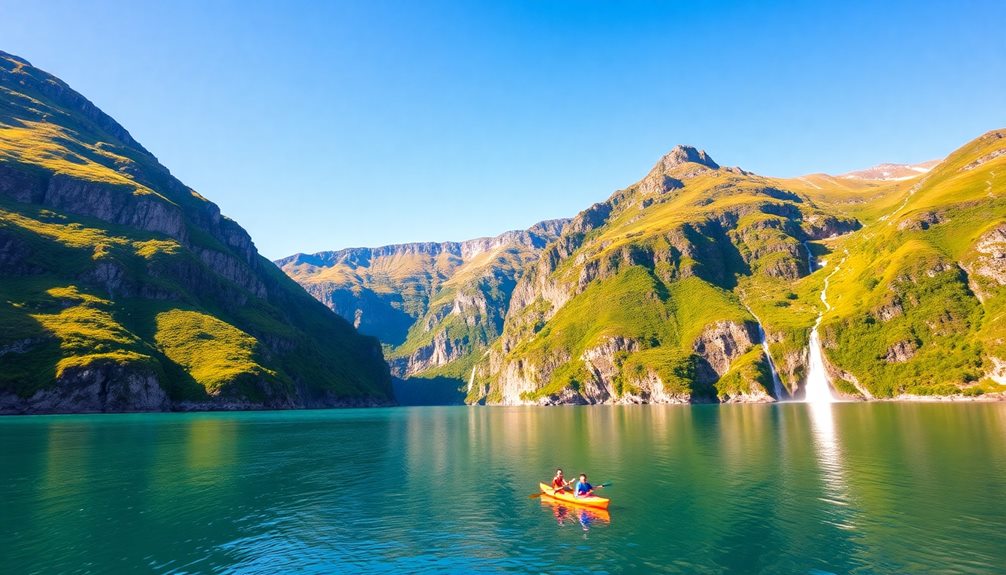
During the summer, the nearly 24 hours of daylight let you make the most of the Norwegian fjords with exciting midnight sun activities.
You'll have plenty of chances to spot wildlife, from soaring eagles to playful seals, as you explore the lush landscapes.
This vibrant season truly enhances your experience, making it a perfect time for adventure and discovery.
Midnight Sun Activities
The midnight sun transforms Norway into a playground for outdoor enthusiasts, offering nearly 24 hours of daylight from late May to late July. This unique phenomenon allows you to fully immerse yourself in a variety of activities that showcase the stunning fjords and landscapes, particularly in the Lofoten Islands and beyond.
You'll find endless opportunities to explore the outdoors, whether you're hiking through rugged terrains, kayaking in tranquil waters, or biking along scenic routes.
Here are some must-try activities:
- Hiking: Traverse breathtaking trails that lead to panoramic views of the fjords.
- Kayaking: Paddle through serene waters, experiencing the fjords from a unique perspective.
- Cultural Events: Participate in local festivals that celebrate the midnight sun, enhancing your connection to the vibrant community.
With the sun shining well into the night, you can enjoy extended adventures and capture stunning photographs under the soft light that highlights Norway's natural beauty.
Make the most of this magical season by embracing the outdoor activities that the midnight sun has to offer.
Wildlife Spotting Opportunities
Summer months in the Norwegian fjords offer nearly 24 hours of daylight, making it an ideal time for wildlife spotting. With the long daylight hours from June to August, you'll experience a wealth of wildlife activity. Fjord cruises become a haven for nature enthusiasts, allowing you to spot seals, porpoises, and majestic eagles soaring overhead.
In addition to these charming creatures, you might catch glimpses of humpback whales and walruses in the rich marine ecosystems of the fjords. These waters are teeming with life, and your chances of spotting these magnificent animals greatly increase during summer.
The lush landscapes also attract diverse bird species, providing excellent opportunities for birdwatching. You'll find everything from puffins to sea eagles gracing the skies.
To enhance your wildlife experience, consider joining guided eco-friendly tours. These tours prioritize responsible viewing practices, ensuring that you can enjoy the beauty of nature while minimizing your impact.
Whether you're on a cruise or exploring on foot, summer in the Norwegian fjords presents unforgettable wildlife spotting opportunities that you won't want to miss.
Winter Scenic Experiences
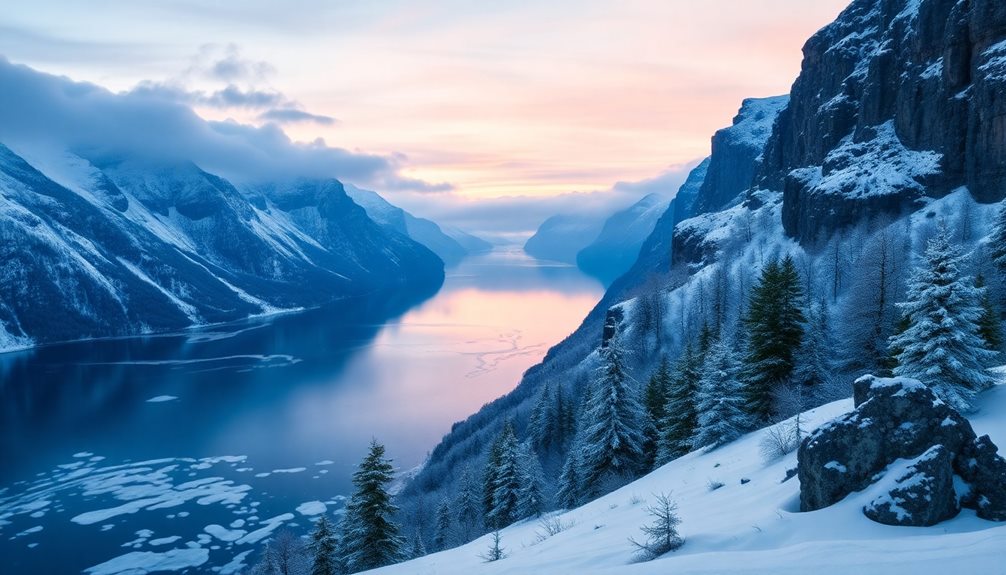
Winter in the Norwegian fjords opens up a world of stunning experiences you'll want to explore.
You can spot majestic whales while enjoying the crisp air and, if you're lucky, witness the mesmerizing Northern Lights dancing across the sky.
Whether you're out on a boat or finding the perfect viewing spot, these winter wonders are sure to captivate you.
Whale Watching Opportunities
Amidst the breathtaking landscapes of Norway's fjords, winter transforms into an extraordinary season for whale watching. From December to March, the Arctic waters become a playground for humpback whales and orcas migrating in search of food. This time of year offers some of the best opportunities to witness these magnificent creatures up close.
When planning your whale watching adventure, keep in mind:
- The best time of year for tours is during daylight hours, which can range from 4 to 8 hours, depending on the month.
- Tromsø and the Lofoten Islands are renowned hotspots, often guaranteeing sightings.
- Many operators emphasize sustainable practices to protect whale habitats while providing unforgettable experiences.
Embarking on a winter whale watching tour not only connects you with nature but also enhances your understanding of marine ecosystems. Knowledgeable guides share insights into whale behavior, enriching your journey through the stunning fjords in Norway.
As you witness these gentle giants, you'll appreciate the unique beauty of the Arctic waters and the importance of preserving their environment for future generations.
Northern Lights Viewing Spots
Beneath the shimmering skies of Norway, the Northern Lights create a mesmerizing show that captivates travelers from around the world. If you're keen to witness this natural wonder, the best time to go is from October to March, with peak visibility in December and January. This period offers long, dark nights ideal for catching the auroras in all their glory.
One of the prime locations for Northern Lights sightings is Tromsø, known for its clear skies and minimal light pollution. From late September to early April, you have a high chance to see the fjords illuminated by the dancing lights.
For a unique experience, consider a fjord cruise, where the stunning landscapes serve as a breathtaking backdrop.
Alternatively, head to Kirkenes in the far northeast, where winter activities like dog sledding and snowmobiling happen under the auroras.
The Lofoten Islands are also fantastic, especially when conditions are clear, providing exceptional photography opportunities.
If you venture to Svalbard, you'll experience the polar night from late October to mid-February, maximizing your chances to see the Northern Lights throughout the night.
Wildlife Spotting Tips
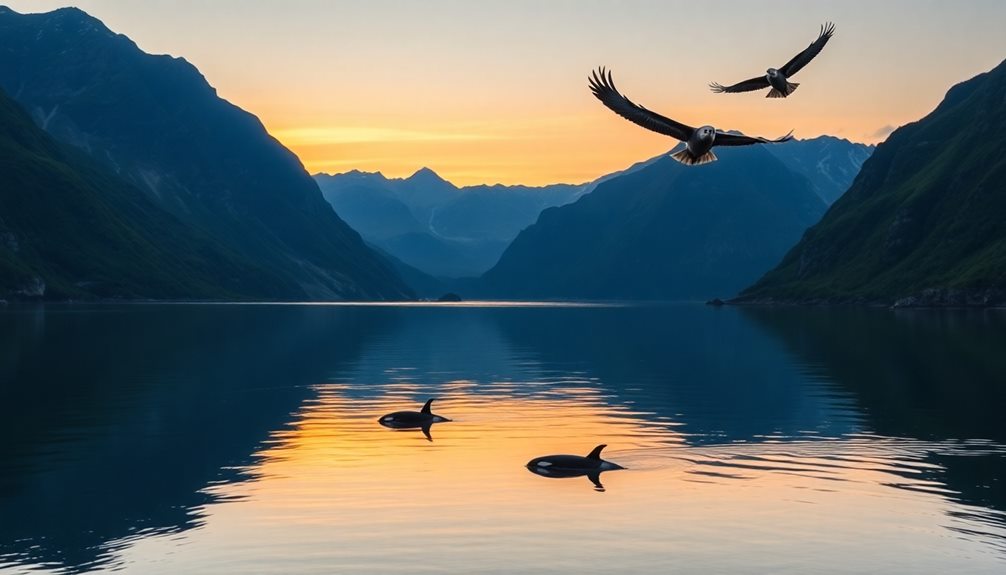
During the summer months, you'll often find the best opportunities for wildlife spotting in the Norwegian fjords.
With nearly 24 hours of daylight, these months provide the perfect time to explore and observe the diverse wildlife.
Here are some tips to enhance your experience:
- Eagle Watching: Head to Sognefjord and Aurlandsfjord for breathtaking views of soaring eagles above the cliffs.
- Whale Spotting: Look for humpback whales in the waters around Vesterålen and Lofoten, where sightings are frequent during the summer.
- Seal and Porpoise Encounters: Early morning or late evening excursions in the Nærøyfjord will increase your chances of spotting seals and porpoises.
Essential Packing List
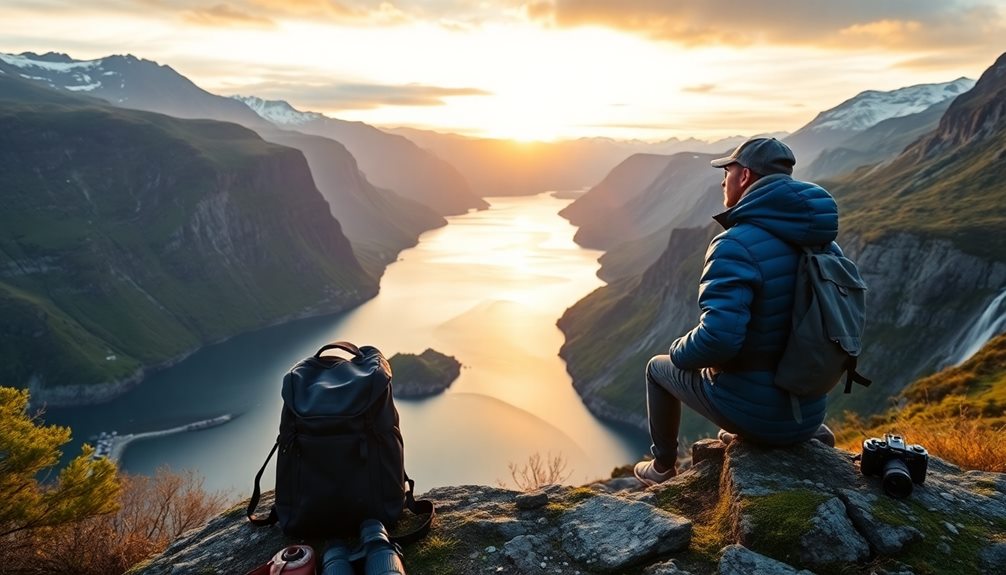
When you're heading to the Norwegian fjords, having the right gear can make all the difference in your experience. Start by packing waterproof clothing, including a durable jacket and pants, to stay dry during unexpected rain showers that often occur in the fjord regions.
Layering is key, so bring thermal tops and fleeces for those temperature fluctuations, especially in spring and autumn.
Don't forget a good pair of gloves and a warm hat to shield yourself from chilly winds, particularly if you're visiting during winter months.
A lightweight backpack is essential for carrying snacks, water, and extra layers during outdoor activities like hiking and kayaking. These adventures will take you through breathtaking landscapes, so be prepared.
Recommended Viewing Locations
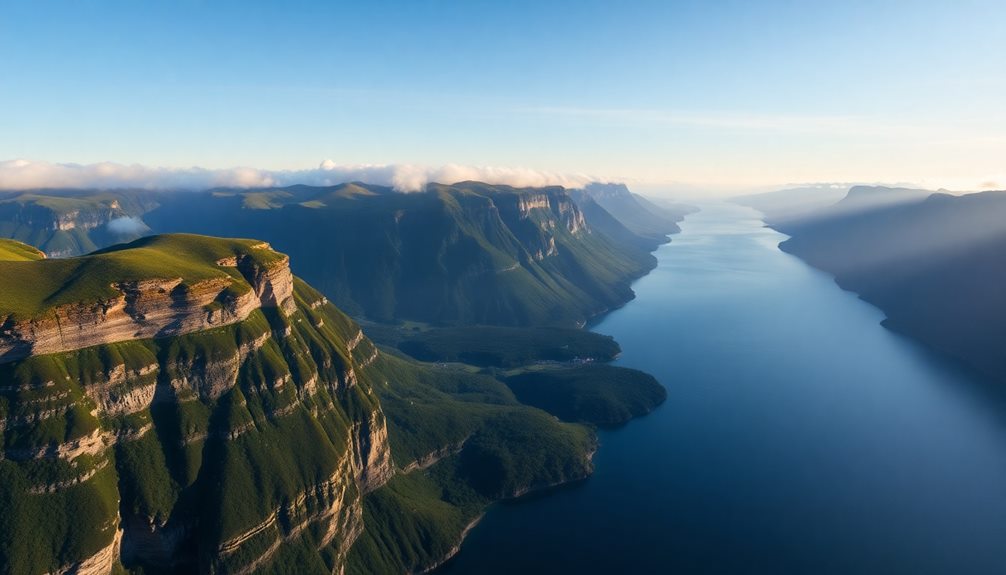
Discovering the stunning beauty of Norway's fjords is a must for any traveler. Each fjord offers unique experiences, making it essential to know the best viewing locations. Here are some top spots to reflect on:
- Sognefjord: As Norway's longest and deepest fjord, it's best visited during summer for kayaking and hiking along its scenic shores.
- Geirangerfjord: A UNESCO World Heritage Site, this fjord is renowned for its breathtaking waterfalls, with the best time to visit being from June to August when the landscape is lush.
- Nærøyfjord: Known for its narrow, dramatic beauty, it's perfect for photography and exploration from May to September, accessible by boat tours.
Don't forget Lysefjord, home to the iconic Pulpit Rock, ideal for summer hiking with stunning sunrise and sunset views.
Meanwhile, Hardangerfjord dazzles with its fruit orchards and waterfalls, particularly vibrant in spring (April to May) and autumn.
The best way to see these fjords is by taking boat tours or hiking trails that provide panoramic views, ensuring you capture the essence of Norway's breathtaking landscapes.
Seasonal Activities in the Fjords
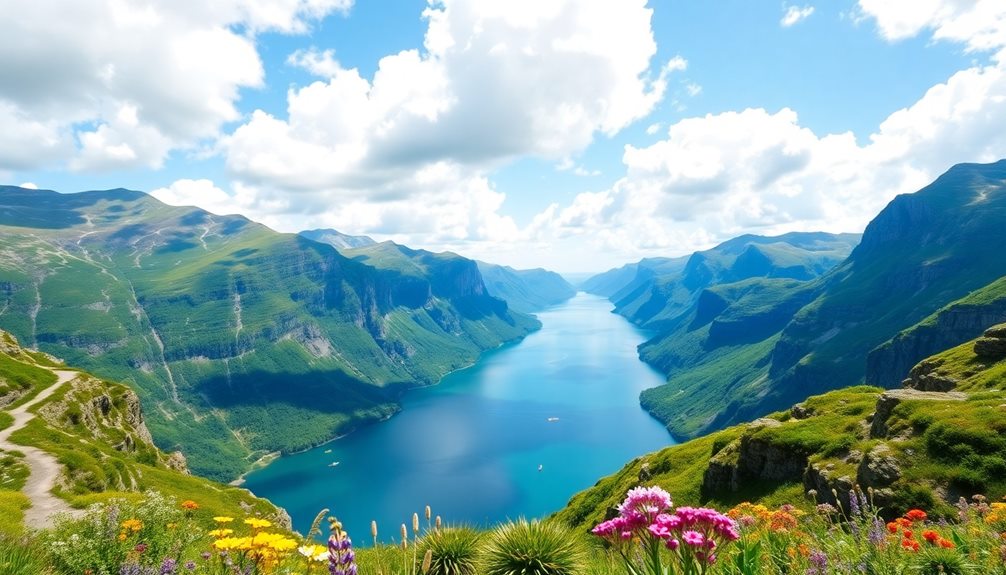
Norway's fjords offer a diverse range of seasonal activities that cater to every type of adventurer.
In summer, when the weather warms up to over 20°C, you can enjoy kayaking, hiking, and scenic boat tours. This is the peak time for exploring the best fjords, as nearly 24 hours of daylight lets you soak in the stunning landscapes.
As autumn rolls in, temperatures drop to around 6°C, making it a great time for hiking amidst the vibrant foliage. If you're lucky, you might even see the northern lights as the season progresses.
Winter transforms the fjords into a snowy wonderland, ideal for snowmobiling and dog sledding, with average temperatures hovering around -4°C.
In spring, the melting snow creates powerful waterfalls and blooming wildflowers. This is an excellent time for birdwatching and enjoying fjord cruises, as the scenery is lush and vibrant.
Each season provides its own unique charm, so no matter when you visit, there are endless seasonal activities to keep you entertained in Norway's breathtaking fjords.
Cultural Events and Festivals
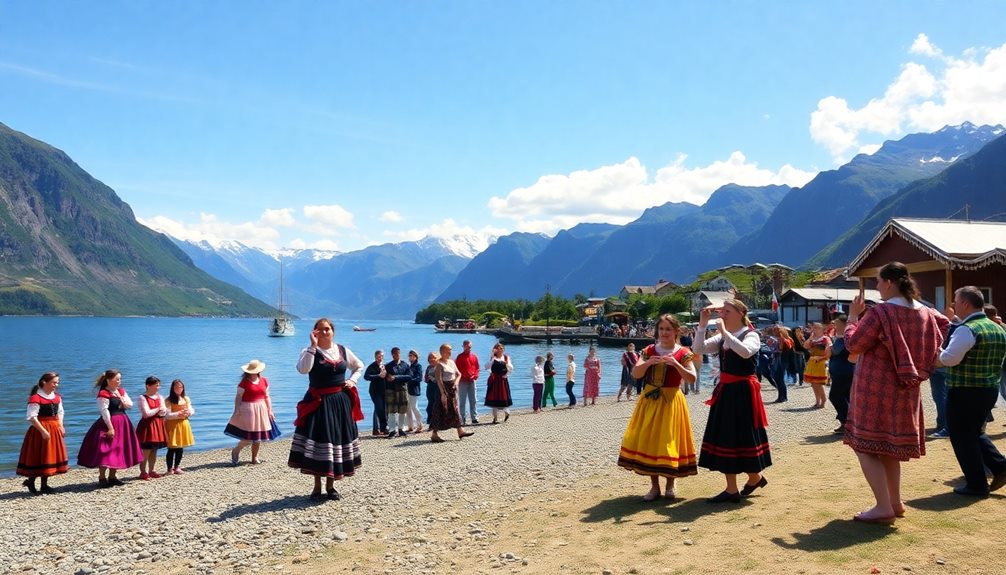
Cultural events and festivals in Norway's fjords provide a vibrant glimpse into the region's rich heritage and community spirit. Attending these events not only immerses you in local traditions but also connects you with the people and their stories.
Here are a few highlights you shouldn't miss:
- Riddu Riđđu Festival: Every July in Kfjord, this festival celebrates indigenous Sámi culture through music, art, and traditional activities.
- Norwegian International Film Festival: Held each August in Haugesund, this festival showcases both local and international films, attracting filmmakers and cinephiles alike.
- Midnight Sun Marathon: In June, Tromsø hosts this unique running event, allowing participants to experience the exhilarating phenomenon of 24-hour daylight.
September brings the Bergen International Film Festival, one of Norway's largest, featuring a diverse selection of films.
Then, as October rolls in, the Dark Season Blues Music Festival in Longyearbyen highlights the Arctic's cultural vibrancy during the polar night with enchanting performances.
Conclusion
To sum up, experiencing the Norwegian fjords is unforgettable, especially if you time your visit right. For instance, if you plan your trip during the summer solstice, you'll enjoy nearly 24 hours of daylight, allowing for extended exploration and stunning sunset views. Don't forget to pack accordingly, as the weather can change quickly. Whether you're hiking or taking a scenic cruise, the fjords offer breathtaking beauty year-round—just make sure you know the best spots and times to visit!
Alfons is the visionary leader and driving force behind Voyager Info’s success. As the Editor in Chief, he brings a wealth of experience and an unwavering passion for travel to the helm of our cruise-centric platform.
With a lifelong fascination for exploring new horizons, Alfons discovered his love for the ocean and cruising at a young age. From sailing across pristine Caribbean waters to embarking on daring expeditions to far-flung destinations, he has amassed a treasure trove of first-hand experiences in the world of cruising.



